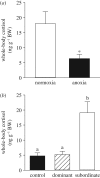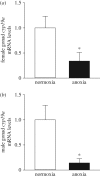Acute embryonic anoxia exposure favours the development of a dominant and aggressive phenotype in adult zebrafish
- PMID: 28077765
- PMCID: PMC5247490
- DOI: 10.1098/rspb.2016.1868
Acute embryonic anoxia exposure favours the development of a dominant and aggressive phenotype in adult zebrafish
Abstract
Eutrophication and climate change are increasing the incidence of severe hypoxia in fish nursery habitats, yet the programming effects of hypoxia on stress responsiveness in later life are poorly understood. In this study, to investigate whether early hypoxia alters the developmental trajectory of the stress response, zebrafish embryos were exposed to 4 h of anoxia at 36 h post-fertilization and reared to adults when the responses to secondary stressors were assessed. While embryonic anoxia did not affect basal cortisol levels or the cortisol response to hypoxia in later life, it had a marked effect on the responses to a social stressor. In dyadic social interactions, adults derived from embryonic anoxia initiated more chases, bit more often, entered fewer freezes and had lower cortisol levels. Adults derived from embryonic anoxia also performed more bites towards their mirror image, had lower gonadal aromatase gene expression and had higher testosterone levels. We conclude that acute embryonic anoxia has long-lasting consequences for the hormonal and behavioural responses to social interactions in zebrafish. Specifically, we demonstrate that acute embryonic anoxia favours the development of a dominant and aggressive phenotype, and that a disruption in sex steroid production may contribute to the programming effects of environmental hypoxia.
Keywords: aggression; developmental programming; dyadic interactions; hypoxia; stress response; zebrafish.
© 2017 The Author(s).
Figures






Similar articles
-
Programming of the hypothalamic-pituitary-interrenal axis by maternal social status in zebrafish (Danio rerio).J Exp Biol. 2016 Jun 1;219(Pt 11):1734-43. doi: 10.1242/jeb.138826. Epub 2016 Apr 4. J Exp Biol. 2016. PMID: 27045091
-
Early-life glucocorticoids programme behaviour and metabolism in adulthood in zebrafish.J Endocrinol. 2016 Jul;230(1):125-42. doi: 10.1530/JOE-15-0376. J Endocrinol. 2016. PMID: 27390302 Free PMC article.
-
High environmental ammonia exposure has developmental-stage specific and long-term consequences on the cortisol stress response in zebrafish.Gen Comp Endocrinol. 2017 Dec 1;254:97-106. doi: 10.1016/j.ygcen.2017.09.024. Epub 2017 Sep 25. Gen Comp Endocrinol. 2017. PMID: 28958860
-
The role of alcohol and steroid hormones in human aggression.Vitam Horm. 2005;70:415-37. doi: 10.1016/S0083-6729(05)70014-5. Vitam Horm. 2005. PMID: 15727813 Review.
-
Zebrafish Behavioral Assays in Toxicology.Methods Mol Biol. 2022;2474:109-122. doi: 10.1007/978-1-0716-2213-1_11. Methods Mol Biol. 2022. PMID: 35294760 Review.
Cited by
-
The Effects of Early Life Stress on the Brain and Behaviour: Insights From Zebrafish Models.Front Cell Dev Biol. 2021 Jul 21;9:657591. doi: 10.3389/fcell.2021.657591. eCollection 2021. Front Cell Dev Biol. 2021. PMID: 34368117 Free PMC article. Review.
-
Combined effects of warming and hypoxia on early life stage Chinook salmon physiology and development.Conserv Physiol. 2019 Feb 18;7(1):coy078. doi: 10.1093/conphys/coy078. eCollection 2019. Conserv Physiol. 2019. PMID: 30834124 Free PMC article.
-
Serotonin Coordinates Responses to Social Stress-What We Can Learn from Fish.Front Neurosci. 2017 Oct 25;11:595. doi: 10.3389/fnins.2017.00595. eCollection 2017. Front Neurosci. 2017. PMID: 29163002 Free PMC article. Review.
References
MeSH terms
Substances
Associated data
LinkOut - more resources
Full Text Sources
Other Literature Sources
Molecular Biology Databases

